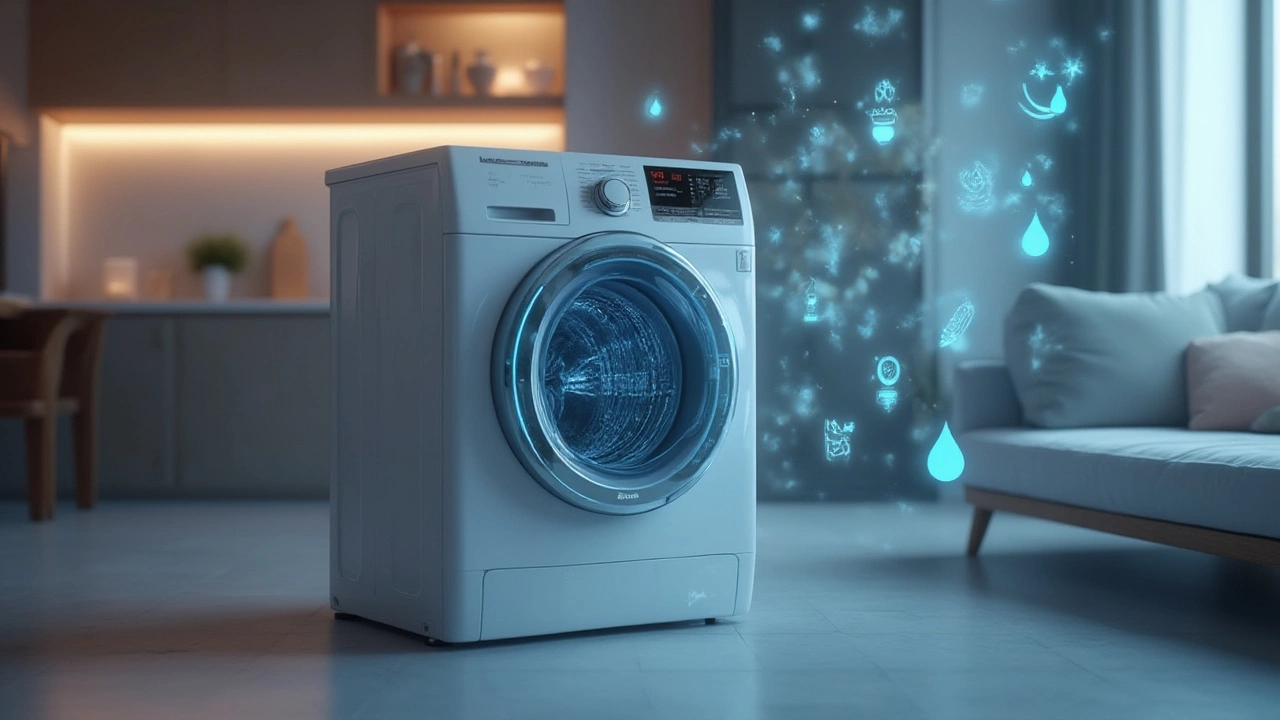
Ever wondered why your neighbor keeps bragging about his "5 star rated washer" while you’re just hoping yours doesn’t spill water across the floor? These ratings aren’t just shiny badges for show—they actually mean something. They can directly save you cash, help the environment, and even make you look good for caring about both. Yet, most people have no clue what goes into those stars. Once you know, you’ll never look at washing machines the same way again.
The Truth Behind 5 Star Ratings: Modern Standards for Efficiency
Let’s get this straight: a “5 star rated washer” isn’t just a fancy marketing term. It’s a legit performance seal—one that can tell you, in the simplest terms, how well a washer uses energy and water. Think of it a bit like those nutrition facts on your cereal box—lots of numbers, but only one real takeaway: is this thing good or bad for me (or my bills)? The easiest way to spot it is the official energy efficiency label, which is actually regulated in most countries by an energy standards board or department. Take India’s Bureau of Energy Efficiency (BEE) or the U.S. Department of Energy’s Energy Star program. Both use stars or special symbols, with more stars meaning a better appliance.
What does a 5 star label get you? For starters, way lower energy bills. According to a 2024 study from the American Council for an Energy-Efficient Economy, a classic top-loading washer from 2010 typically uses 100-120 kWh per year and about 18,000 gallons of water, while a modern 5 star rated washer can drop that to just 65 kWh and 9,000 gallons. Crazy, right? That’s half the water and almost half the electricity, for a job you do at least once or twice a week.
There’s more. A 5 star washer isn’t only about saving kilowatt-hours or gallons. These ratings also push manufacturers to create machines that are gentle on fabrics, better at cleaning, and quieter. Most 5 star washers feature inverter motors—meaning they only use as much power as your laundry load actually requires. No more spinning a nearly empty drum at full blast. Some brands like LG and Samsung publish detailed test results for their washers that back up their claims—like the LG Front Load 5 Star WM3501 washing machine, which maintains 99.9% bacteria removal and whips through a full load in under 40 minutes at about 60 liters per cycle. That’s wild, considering older machines easily wasted twice the resources for worse results.
But don’t just trust the stickers. Governments and consumer watchdogs regularly spot-check these machines. In one 2023 sweep, U.S. Energy Star found only two out of 80 washers failed to match their 5 star claims. So when you see the rating, it’s usually legit—unless you’re buying a knockoff online, but that’s a whole other headache.
Here’s a glance at how historic data stacks up among washing machine types:
| Washer Type | Avg. Annual Energy Use (kWh) | Avg. Water Use (gallons/year) | Avg. Load Size (cu ft) |
|---|---|---|---|
| Classic Top-Loader (2010) | 117 | 17,900 | 3.0 |
| Modern Top-Loader (3 Star) | 85 | 13,400 | 3.5 |
| Front-Loader (5 Star Rated) | 62 | 8,700 | 4.5 |
Pretty clear: that extra star really slashes your running costs and environmental footprint. But there’s more magic inside these machines than just efficient motors and low-flow valves.

What Sets a 5 Star Washer Apart? Modern Features You Can Feel
A 5 star rated washer is like moving from a flip phone to a smartphone—it’s not just cleaner clothes, it’s a whole new vibe. First up, these washers tend to pack “smart” tech: Wi-Fi connectivity, app controls, voice assistant compatibility. Ever started a cycle from work or checked how long your laundry’s got left while watching TV? Yeah, this is where things get sci-fi. Samsung’s 2025 SmartFront 9000 lets you set up personalized wash cycles using its app and gives you tips to save even more water and power, based on your actual laundry data.
Let’s get real about convenience. The best washers with 5 star ratings don’t just wash and spin—they’re the laundry whisperers. They adjust water and detergent based on the type and size of your load. Your favorite gym tee gets a gentle soak, but those gravy-stained napkins get a powerful blast. Some have allergen-removal modes certified by places like the British Allergy Foundation. Newer machines like Bosch’s 5 Star Series even remember your preferences, so you can just press one button and go.
Time is another winner here. Old washers used to take close to two hours to clean a full load, while modern 5 star machines—thanks to turbo wash features—knock that down to 40 or 50 minutes without leaving behind half-soaked socks. Recently, Whirlpool’s UltraEco line was tested to finish a regular soil load in 35 minutes, using under 50 liters of water.
If you’re sensitive to noise, there’s great news: inverter motors in these machines mean a lot less racket. LG’s latest models hit just 48 decibels on the spin cycle—about as loud as a quiet suburb at night. Compare that to your grandma’s old washer that could drown out a chainsaw.
Another sign you’re dealing with a real 5 star champ? Strong build and warranties. High-end washers use corrosion-resistant drums, auto drum-cleaning cycles, and even have filters that catch pet hair and microfibers (which can otherwise end up in our oceans). According to Consumer Reports, machines with a genuine 5 star efficiency rating also tend to break down less—a 2023 reliability survey showed front-loaders with top energy ratings had 30% fewer repairs in the first five years than those with only 3 or 4 stars. That’s not just less hassle, but more money saved long term.
Of course, “set it and forget it” is the best modern feature. With connected models, you can download new cycles for special fabrics, or even get reminders when it’s time to clean your drum. For folks with allergies, built-in steam and sanitization cycles (think LG’s AllergyCare or Whirlpool’s SteamFresh) are big selling points—killing germs and pollen so your sheets are really safe for kids.
Here are some features you’ll often find in the best 5 star rated washers:
- Inverter direct drive motor (quiet, variable speed, ultra-efficient)
- 6 or more wash programs (Delicates, Heavy Soil, Quick, Eco, etc.)
- Load sensors (automatic water adjustment)
- Self-clean and anti-bacterial drum cycles
- Real-time app tracking and voice compatibility (Google Assistant, Alexa)
- Highly rated warranties (3+ years on parts, 10 years on motor)
- Fabric care modes: baby, allergy, sportswear, wool
- Low noise (under 50 dB in most cycles)
- Pet hair and microfiber filter options
- Child lock safety
This all adds up to a smoother, smarter laundry experience. You start to expect more from your machine—like maybe it should fold clothes too. (Sorry, not there yet, but who knows by 2030?)

Tips for Picking and Using a 5 Star Washer: Getting the Most Bang for Your Buck
Reading all this and thinking, “OK, but how do I actually choose the right one?” It’s honestly easier than you’d think, especially if you keep a few things in mind. First, don’t get hypnotized by fancy color finishes or massive control panels. Focus on the basics: does the model list a 5 star rating from a legit standards body (like Energy Star in the US, BEE in India, or EU Energy Label)? If it’s not easy to find online or on the display sticker, skip it. Counterfeit or exaggerated claims are unfortunately common from no-name brands—if the price seems ridiculously low, that’s a red flag.
Next up: size matters. If you live alone or with one other person, a 6 kg (13 lb) drum is plenty. For families, think 7-9 kg (15-20 lb). Too small and you’ll be running five loads a week; too big and you’ll never fill it, wasting water and time. Pay close attention to the rated water consumption per cycle—the best models use 8-10 liters per kg, while older or poorly designed machines could double that.
Quietness is worth considering. If your laundry space is close to the main living area, check for noise ratings on both wash and spin. Less than 50 dB is ideal—if you can, listen to one work in-store (YouTube videos help too). Vibration reduction is key for older apartments or homes with thin floors, so look for models highlighting this feature in their product details.
Real talk: maintenance. Even the world’s greatest washer can get stinky or clogged if you don’t clean it. Thankfully, 5 star rated washers almost always come with at least a drum-clean program, and some remind you via app notifications. Use these monthly. Clean the filter and detergent tray every three months, or if you notice odd smells. Always leave the door open after a wash for at least half an hour to prevent mold—a small step that makes a big difference.
Already have solar panels at home? You’re in luck. Most newer washers with inverters draw super low power (as little as 200-500 watts per cycle), so running them midday with solar can mean your laundry is nearly free, energy-wise. That makes a big dent in your yearly bills.
Don’t forget to check for rebates or local discounts. Power companies and government agencies sometimes offer money back for high-efficiency machines. In 2025, certain U.S. states were offering up to $150 to switch from an old clunker (less than 3 stars) to a modern 5 star machine—enough to cover half a year of electricity costs for the washer itself. Always ask before you buy, especially if you’re shopping in-store. Some brands will even take your old washer away for free.
Few pro tips for happy 5 star washing:
- Use HE (high-efficiency) detergents—your machine will work better, and you’ll avoid dreaded suds issues.
- Sort your laundry for shorter, colder cycles; 90% of modern stains clean up in cool water, and you’ll save tons of energy.
- Don’t overload! Even the best machine needs a little space to work its magic.
- Regularly update your washer’s app if it’s got one—brands push out new features and fixes every few months.
- Check hoses and connections every year—nothing ruins efficiency like a tiny leak.
Ready for a new washer that brightens your clothes, saves money, and hushes the nightly rumble? Start by hunting down that 5 star rated washer. With a good eye, a few questions, and the tips above, your laundry game will never be the same. Who’d have guessed a simple rating could change how you see a chore you’ve done a thousand times?